Worldwide, more than eight-in-ten migrants born in El Salvador, Guatemala and Honduras live in the United States, according to United Nations estimates. That included 89% of Salvadoran migrants, 86% of Guatemalans and 82% of Hondurans in 2015.
Among all those born in El Salvador worldwide – those who live in El Salvador and those who live elsewhere – 23% reside in the U.S., according to United Nations figures for 2015. For Guatemalans and Hondurans, the shares in the U.S. are smaller – 6% and 8%, respectively – but still consequential.
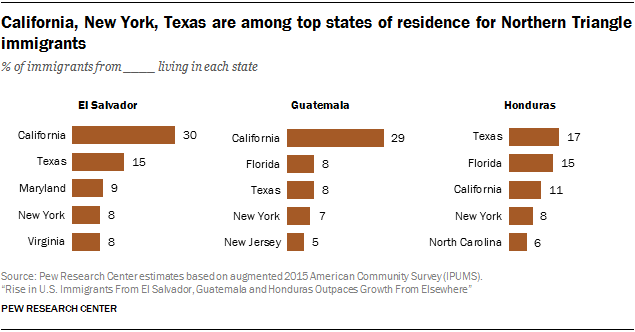
Most Northern Triangle immigrants live in states that also are popular with other immigrants, especially those from Latin America. In all, 84% of Salvadoran immigrants lived in the 10 most popular states for immigrants from their country in 2015, as did 72% of Guatemalan and 79% of Honduran immigrants. Nearly three-quarters (74%) of immigrants overall lived in the most popular states for the foreign-born population.
More than any other state, California has the largest share of Salvadoran immigrants (30% lived there in 2015) and Guatemalan immigrants (29%). It’s also the top state for U.S. immigrants overall – one-in-four live there. For Hondurans, though, Texas (17% in 2015) and Florida (15%) are at least as popular as California (11%). Texas has the second largest population of U.S. immigrants; 11% lived there in 2015.
However, several states that are not among the top 10 destinations for immigrants are popular with those from Northern Triangle countries. They include Maryland for immigrants from all three countries, North Carolina for Guatemalans and Hondurans, Nevada for Salvadorans and Louisiana for Hondurans.
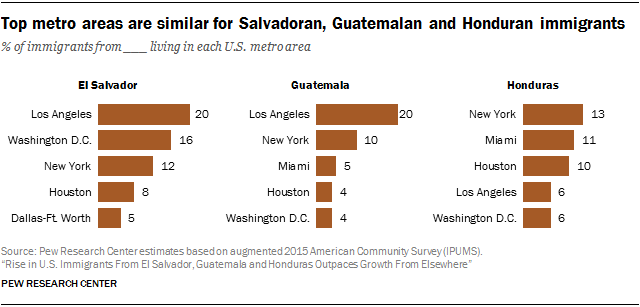
Immigrants from the three countries also are most likely to live in metro areas that are popular destinations for other immigrants, according to 2015 census data.
The top five for each group include Los Angeles, New York, Washington, D.C., and Houston, as well as Dallas (for Salvadorans) and Miami (for Guatemalans and Hondurans). A higher share of Salvadorans live in their top 20 metro areas (81%) compared with Guatemalans (67%) and Hondurans (70%). Among all immigrants, 65% live in the top 20 metros.
Among the nation’s 50 largest metropolitan areas, a Northern Triangle nation is the largest birth country in only two. Salvadorans are the largest immigrant group in the Washington, D.C., metropolitan area, and Hondurans are the largest in New Orleans, according to 2015 Census Bureau data.
Most Northern Triangle immigrants have lived in the U.S. a decade or more
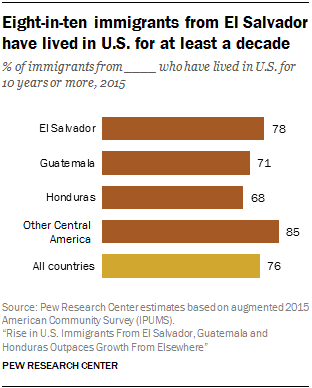
Despite the large number of immigrants who arrived in the past decade, most immigrants from El Salvador, Guatemala and Honduras have lived in the U.S. for 10 years or more, as is true for the majority of all U.S. immigrants.
Among immigrants in 2015, 78% from El Salvador, 71% from Guatemala and 68% from Honduras had lived in the U.S. for 10 years or more. Immigrants from other Central American nations are even more likely to be longer-term U.S. residents: 85% have lived in the U.S. for at least a decade as of 2015. Among all U.S. immigrants in 2015, 76% lived in the U.S. for 10 years or more. The share of immigrants in the U.S. for 10 years or more has risen for all these groups since 2007.
Most unauthorized immigrants also have lived in the U.S. for at least 10 years. The share residing in the U.S. a decade or more has risen since 2007 for all unauthorized immigrants, for Northern Triangle unauthorized immigrants and for other Central American unauthorized immigrants. For unauthorized immigrants overall, as well as for those from Guatemala and Honduras, the share in the U.S. for 10 years or more has been a majority since 2007.
For comparison purposes, immigrants from Mexico are at least as likely as those from Northern Triangle nations to have lived in the U.S. for a decade or more. Among all Mexican immigrants in 2015, 85% had; among unauthorized immigrants from Mexico, 80% had.
U.S. immigrants from El Salvador, Guatemala and Honduras are especially likely to be of working age – 18 to 64. Among all immigrants, 80% were in this age group in 2015, but that share is nearly nine-in-ten among Salvadorans (88%), Guatemalans (86%) and Hondurans (87%). By contrast, among all people born in the U.S., 60% were of this age in 2015.
Guatemala is the only Northern Triangle country from which there are substantially more men (59% in 2015) than women (41%) among U.S. immigrants. The shares are nearly equal for Salvadorans and Hondurans, as they are for U.S. immigrants overall. However, there is gender imbalance in the other direction among other Central American immigrants; this group is 56% female. Among all U.S. immigrants, 50% are female.
The labor force status of Northern Triangle immigrants varies by gender. Men from the Northern Triangle are more likely to be working or looking for work than immigrants overall or people born in the U.S. Among those ages 18 to 64, 91% of Northern Triangle male immigrants were in the labor force in 2015, compared with 86% of all male immigrants and 79% of U.S.-born men.
Among women ages 18 to 64, labor force participation varies by birth country, but it is lower than for all U.S.-born women. Linked to their lower labor force participation is their greater likelihood to have young children at home. Northern Triangle immigrants are at least twice as likely as U.S.-born women to have young children at home.
Most Northern Triangle immigrant homes include children
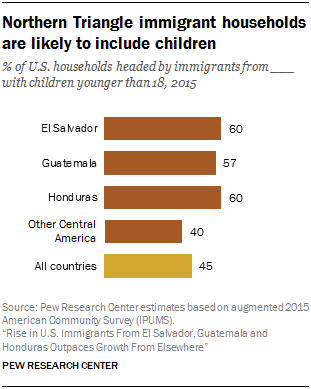
Households headed by immigrants from Northern Triangle nations are more likely to include children younger than 18 than immigrant households overall in the U.S. While 45% of immigrant households included minor children in 2015, the share was 60% for those headed by a Salvadoran immigrant, 57% for those headed by a Guatemalan immigrant and 60% for those headed by a Honduran immigrant. Among households headed by other Central American immigrants, 40% included minor children. (By contrast, only 29% of households headed by a U.S.-born adult included children in 2015.)
The share of households with children is higher for homes headed by unauthorized immigrants than by lawful ones. Among all Northern Triangle unauthorized immigrant households, 63% had minor children in 2015, compared with 55% for households headed by a lawful Northern Triangle immigrant.
A single-person household – someone living alone – is relatively uncommon for Central American immigrants, especially those from the Northern Triangle. Among Salvadoran immigrants, 9% lived alone in 2015, compared with 12% for Guatemalan immigrants and 14% for Honduran immigrants. Among all immigrants, 19% did. Among all the U.S. born, 30% did.
According to other census data for individuals (not households), about four-in-ten immigrant adults from the three Northern Triangle nations live with minor children. The vast majority of those immigrant adults – about nine-in-ten – live with U.S.-born children, who are U.S. citizens at birth.
Education levels relatively low for Northern Triangle immigrants
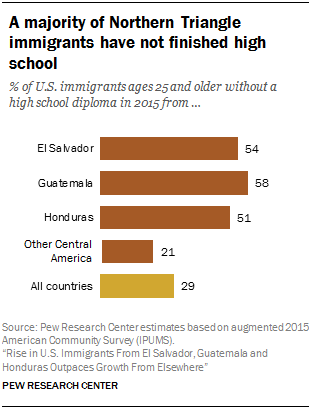
The educational attainment of the immigrant population from Northern Triangle nations is below that of all U.S. immigrants. Among those ages 25 and older, half or more from each country have not completed high school, compared with 29% of all immigrants, according to 2015 U.S. Census Bureau data. Most of those who have not finished high school have less than a ninth grade education; fully 39% of Northern Triangle immigrants had this level of schooling in 2015.
Among Northern Triangle immigrants in 2015, 27% had a high school diploma or GED equivalent and no further education, 11% had some college education or a two-year degree and 7% had a bachelor’s degree or more. The comparable shares for the foreign-born population overall in 2015 were 26%, 15% and 30%.
In looking at educational attainment, legal status matters: Most Northern Triangle unauthorized immigrants have not completed high school (60%), compared with 48% of lawful immigrants from the region.
Educational attainment is notably higher among U.S.-born residents with roots in the three Central American nations. In that group, the vast majority has a college degree (24% in 2015), some college (30%) or a high school education (30%). Only 16% did not complete high school.
Most Northern Triangle immigrants are not proficient in English
Immigrants from El Salvador, Guatemala and Honduras are less likely than other foreign-born residents of the U.S. to be proficient in English. English proficiency is defined as either speaking only English at home or, if someone speaks another language at home, that person speaks English very well.
In 2015, half of U.S. immigrants ages 5 and older (51%) were proficient in English, compared with almost a third of those from the Northern Triangle.
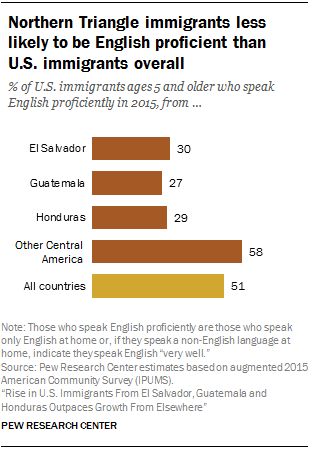
Most households of immigrants from Central America speak a language other than English at home. Among immigrants ages 5 and older, only 4% from El Salvador, 7% from Guatemala and 4% from Honduras spoke English and no other language at home in 2015. Nearly all who do not speak only English at home said they spoke Spanish. By comparison, among all immigrants, 16% spoke only English at home, according to 2015 census data.
English proficiency tends to be higher for immigrants with college degrees and lawful status. As with education levels, immigration status is relevant: Unauthorized immigrants from each of the three countries are less likely to be proficient than lawful immigrants. The relatively high share of Northern Triangle immigrants who do not have high school diplomas or lawful status helps explain their relatively low levels of English proficiency.




